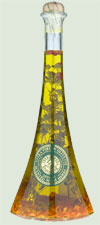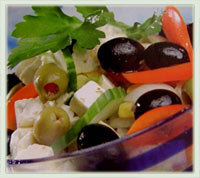cretan olive oil
Cretan Olive Oil
The composition of the soil and the climatic conditions that predominate on the island of Crete Greece, in combination with the microclimate of its northwestern region (location of Kolymbari), form the ultimate environment for the production of the highest quality olive crop.
When Mother Nature completes her task, the people of Crete dynamically harvest and process her miracle!
more about cretan olive oil
Greek Olive Oil
Greece devotes 60% of its cultivated land to olive growing. It is the world's top producer of black olives and boasts more varieties of olives than any other country.
Greece holds third place in world olive production with more than 132 million trees, which produce approximately 350,000 tons of olive oil annually, of which 82% is extra-virgin olive oil. The olive is a crop – the fruit of the olive tree. When the cultivation methods and the pressing procedures at the factory have retained the highest standards of quality within the olive oil, only then can it be labeled as “Extra Virgin.”
About half of the annual Greek olive oil production is exported, but only some 5% of this quantity reflects the origin of the bottled product. Greek exports primarily target European Union (EU) countries, the main recipient being Italy, which receives about three-quarters of total exports.
Olives are grown for oil in mainland Greece, Peloponnese, Crete, the Aegean Islands and Ionian Islands.
 Extra Virgin Olive Oil with Aromatic Herbs
Extra Virgin Olive Oil with Aromatic Herbs
Thousands of years ago, Greeks used aromatic olive oil both for cooking and cosmetic purposes
more about Extra Virgin Olive Oil with Aromatic Herbs
Cretan Olive Oil - History
 Since antiquity, the concepts of “The Mediterranean” and “the olive” have been interwoven. According to Mediterranean historian, F. Brodel, “The Mediterranean begins where the first olive trees bloom and finishes where the first palm-tree forests line the African continent.”
Since antiquity, the concepts of “The Mediterranean” and “the olive” have been interwoven. According to Mediterranean historian, F. Brodel, “The Mediterranean begins where the first olive trees bloom and finishes where the first palm-tree forests line the African continent.”
During prehistory, humankind decided that collecting the fruit of wild olive trees did not suffice to fulfill its needs, and thus began the systematic production of the olive crop by initially domesticating the indigenous, wild tree and subsequently creating olive groves.
This long-drawn, laborious process is widely held to have begun on Crete. “The honour of having converted the wild olive into cultivated trees belongs to the peasants of Crete,” observes ...
more about cretan olive oil history
Total Quality in Olive Oil is Achieved When:
-
The olive crop is healthy and wholesome.
-
It is transported to the factory on the same day to immediately undergo the pressing procedure.
-
Throughout all the stages of production, it is never exposed to temperatures exceeding 27° Celsius.
-
The olive oil produced is thoroughly evaluated and accordingly stored.
-
It is strictly assessed as to all its possible parameters prior to its transport and bottling.
-
The storage area that accommodates either the olive crop or olive oil in any form must be free of insects, rodents, microorganisms, bacteria, etc.
-
Strict inspections are conducted on the packaging/bottling material that come in contact with the olive oil, insuring that they are produced exclusively in factories that apply systems of safety and hygiene throughout the manufacturing process.
-
All personnel involved in all the stages of production are certified and healthy.
-
From the grove to its packaging, the whole step-by-step conveyance of the product is monitored. (What is called “traceability”)
The olive and olive oil in modern times
Even though western European habits in attire, culture and nutrition were adopted by the Greeks during the last century, what is remarkable is that the sector of olive oil not only resisted this new inclination, but also became the only Greek element that imposed itself on the rest of Europe.
 The increasing trend of the Cretan diet, which for obvious politico-economical reasons has been renamed as the Mediterranean diet, began over the past decades and is now gaining rapid ground worldwide, year by year. According to statistics, the consumption of olive oil in Europe, as well as throughout the world, is on a steady increase.
The increasing trend of the Cretan diet, which for obvious politico-economical reasons has been renamed as the Mediterranean diet, began over the past decades and is now gaining rapid ground worldwide, year by year. According to statistics, the consumption of olive oil in Europe, as well as throughout the world, is on a steady increase.
Populations of countries that traditionally consumed animal fat have acknowledged the dietary value of olive oil and over the past few years have been converting their dietary habits. This fact has had positive psychological and economical repercussions on olive-producing countries.
find out great recipes with cretan olive oil
Organic Produced Extra Virgin Olive Oil.
This Extra Virgin Olive Oil not only bears all the positive characteristics of the cretan olive oil, but, along with its certification of quality and origin, it is produced from olive trees that are cultivated exclusively with traditional methods, devoid of chemical substances and fertilizers.
more about Organic Produced Extra Virgin Olive Oil
Olive Oil Elements:
Acidity:
This marks the presence of free fatty acids in the olive oil. These fatty acids in their free form are detrimental to cells, and as such we strive towards the lowest possible values. The ACIDITY rate which characterizes each olive oil product has always been a basic criterion of choice.
K232/K270/DK:
These values indicate the presence of various acidulous substances in the olive oil. The lower the finding, the greater is the retention of the product’s freshness.
Peroxide:
This indicates the acidic condition of the olive oil (rancidity/rankness). The lower the findings, the lower the percentage of acidulous substances harmful to cells.
Waxes:
The olive crop is covered by waxy substances produced by the olive tree in order to protect its fruit from the environment. In part, this permeates the olive oil during the processing of the crop at the factory. Low findings of waxes are indicative of a product that has been extracted under optimum conditions at the factory and therefore boasts better quality and longer retention of freshness.
more about olive oil quality

